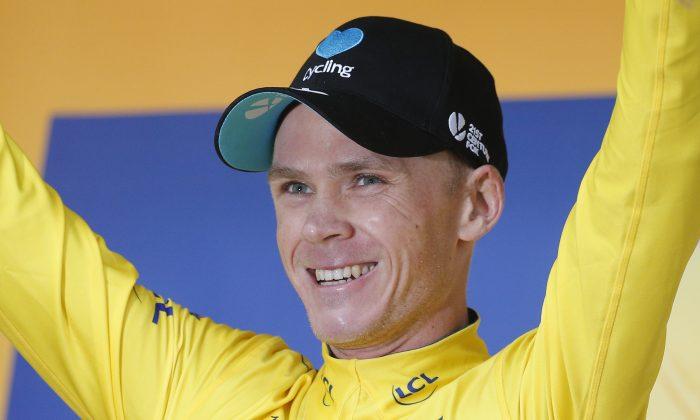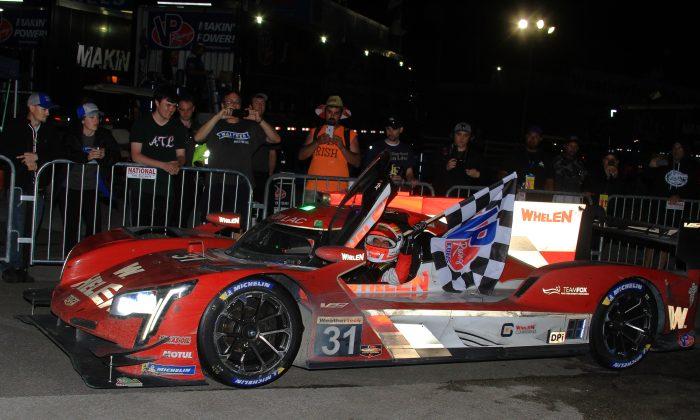Sky’s team leader Chris Froome has a 1:47 lead over Trek’s Bauke Mollema and 2:59 over his chief rival, Movistar’s Nairo Quintana, with only four stages left in the 2016 Tour de France.
The four stages, in total, are the toughest in the Tour: Three Alpine stages with two mountaintop finishes, and one uphill time trial, 12 categorized climbs including one Hors Categorie in each stage.
These are difficult stages, but so far Froome has shown himself to be the strongest of the General Classification contenders—and with his lead, all he needs to do is follow his rivals. it is up to the rest of the field to attack, if they want to win, and so far, no one has been able to drop Froome.
No team has managed to crack this year’s Sky squad, either. Astana did briefly put Sky into a bit of difficulty in Stage 16, but at no time was Froome isolated.

Contador Departed, Quintana Quiescent
The flavor of the race soured in the openning two stages, as the man most considered to be Chris Froome’s toughest rival, Tinkoff’s Albeerto Contador, crashed twice, losing time and doing sufficient damage that the 33-year-old Spaniard was never again competitive.
Contador, already a multiple Grands Tour winner with two Tours de France on his palmares, had to withdraw the day before the first rest day after he woke up with a fever on top of all his accumulated injuries. Once he realized that he had nothing to gain in the Tour, Contador decided to focus on the Vuelta a España in late August.

This left the young Colombian climber Nairo Quintana of Movistar as the man most likely to challenge from for the overall win. The Movistar team leader, only 26, won the Vuelta a España in 2014, and second in the Tour de France in 2012 and 2015.
Quintana is a climbing specialist, who prepared for the Tour by riding at altitude around his home town of Cómbita, Colombia. he announced his plan to beat Froome in the third week of the Tour, in the Alpine stages—and he will need to do a lot in these stages, based on his previous performances this Tour.
The only time Nairo Quintana showed any desire to attack Chris Froome was in Stage 12, when the Movistar rider put in a series of short digs on the shortened climb up Mont Ventoux. Froome didn’t react—whether he could have or not—but let his team mates cover the moves, and simply rode his own pace uphill until he caught Quintana.
Other than that, Quintana has been content to follow along, losing small increments of time until, heading into the final several stages, the Colombian is three minutes behind the leader.
Three minutes would not be a lot, if the leader was not Chris Froome and if his team was not this year’s Team Sky. Movistar will need to push the pace on every climb, to wear down Team Sky, and then Quintana will need to attack repeatedly, to wear down Chris Froome—but so far there has been no sigh that either Movistar or Quintana has the needed capacity.

The Strength of Sky
Sky’s general approach to all attacks was the same: no abrupt accelerations to follow the opponents’ accelerations—too much cost for too little result. Instead Sky’s riders, particularly Wouter Poels, sped up slightly and caught the attacker when he inevitably slowed.
Only in Stage 16 did any team even slightly discomfit Team Sky—and that came after a high-speed crash had shaken up three Sky riders. And even so, Wout Poels never wavered, staying by Chris Froome’s side until Astana’s attack lost steam.

Froome Unafraid
Chris Froome showed his willingness to launch hard attacks, as he did in Stage 12. Who knows how much he might have gained on his rivals had he not collided with a stalled motorbike in the last kilometer of the stage?
Stage 12 was, in its way, decisive, because it showed that Froome could cover Quintana’s attacks, and then could counterattack and drop the Colombian climber. Stage 13, the time trial, only added to Froome’s lead, possibly swelling it enough to secure the overall win.
The rest of the GC contenders turned in decent rides, but Froome rode an excellent race, finishing second on the stage and gaining a lot of time on the rest.
Chris Froome, and the entire Sky squad, seem tremendously relaxed this year, as though they know that they have the race in hand. This relaxed pace shows in their covering attacks—and helps in covering attacks. Calm riders waste less energy and make fewer mistakes. If Chris Froome et al can maintain this composure, it seems unlikely that their rivals could prevail.

Strong Enough, Smart Enough
Chris Froome has not been able to ride away from his all rivals when he has attacked. He dropped Quintana in Stage 12, but that was after the Movistar leader had launched several attacks of his own, all of which were covered by Froome’s team mates. Richie Porte not only stayed with Froome on that stage, but looked be on the verge of riding away when the collision with a motorbike spoiled the stage.
Instead, Froome has gained time in other ways: via his strong time trial and by attacking on a descent in Stage Eight and in Stage 11, a flat stage.
Stage Eight was the first real mountain stage, with four categorized climbs. Froome and Quintanan crested the final time together; while Quintana slowed to take a bottle and take a drink, Froome immediately attacked, using his hitherto undisplayed excellent descending skills to open a 20-second gap.
Stage 11 was viewed as a simple sprint stage, but fierce crosswinds shattered the peloton into several sections in the second half of the stage. Team Tinkoff repeatedly jumped into echelon every time the wind hit, continually splitting the peloton as any rider who wasn’t prepared got caught out and dropped.
As the wind eased, the peloton reformed, but Tinkoff wasn’t done. When the wind returned 30 km from the finish, peter Sagan and one Tinkoff team mate attacked the peloton. Chris Froome was expecting the move, and immediately latched onto Sagan’s rear wheel, bringing team mate Geraint Thomas with him.
This quartet were too powerful for the peloton to catch, and Froome finished second on the stage, earning another 11 seconds.
This combination of power and strategy recalled an earlier era of cycling, where every stage didn’t follow some standard playbook: Sprint, Mountain, or Intermediate/Breakaway. Froome’s eagerness to grab seconds wherever he could find them has earned him a comfortable lead while still allowing him to stick to his pre-race plan, which was to save energy during the first two weeks so he could fight harder in the final week.

The Rest of the Best
Adam Yates of Orica–BikeExchange lies third in the General Classification. The 23-year-old Brit leads the Best Young Rider jersey by three minutes over Lampre-Merida’s Louis Meintjes; it seems completely possible he could win this competition.
Chances are a lot slimmer that Yates will hang onto a podium place in the overall. He has faltered a bit on some of the tougher climbs, and with four days packed with climbing, it is questionable that his still-developing young legs will be able to support him well enough to beat the likes of Nairo Quintana, Alejandro Valverde, Romain Bardet, or Richie Porte, all of whom are within a minute and a half of the young rider.
Quintana and Valverde, 2:59 and 3:17 behind Froome, both look like contenders, but three minutes is a lot to make up in four stages against a rider who had shown no sign of weakness. Valverde is almost certainly not a strong enough climber to keep up with Froome through four mountain stages; his job will be to help Quintana as much as he is able, then peel off and let the young Colombian go mano-a-mano against Froome.

One rider who is showing surprising strength is Trek-Segafredo’s Bauke Mollema. At 29, Mollema is in his prime as a cyclist, and he has been riding the best Tour of his life so far. He has three top-tens in the Tour, finishing as high as sixth in 2013 and seventh in 2015. he has never been one of the top contenders, yet this year the Dutch rider is only 1:47 behind Chris Froome.
Mollema rode a respectable time trial, finishing sixth and losing only 51 seconds to Chris Froome. He has been climbing well; he was the only other rider able to catch Froome and Porte when Froome attacked in Stage 12.
His team, Trek-Segafredo, has some strength, but perhaps too much experience. This shouldn’t matter, because Mollema only has to mark Chris Froome. He can ignore every other attack, and wait for his chance. Can he match Chris Froome, head-to-head, in the high mountains? This remains to be seen.
Romain Bardet of Ag2R doesn’t have the team to support him. He also doesn’t have to cover any moves except those of Chris Froome or Quintana. He hasn’t shown the strength to be able to hang with Froome, and unless the Sky leader cracks badly, it seems impossible that Bardet could overcome his 4:04 deficit.
Possibly the strongest rider in the field after Chris Froome this year is BMC’s Richie Porte. After years as Froome’s lieutenant, Porte left Sky to try his hand at leading a team, and so far has been the only rider able to match the race leader on the climbs. Porte, unfortunately, lost a lot of time in Stage two with a mechanical issue, and was pretty much out of the running immediately.
Rested and Ready
In previous Tours, Sky’s preference was to hit the mountain stages extremely hard, to keep the pace so high that no one could launch an attack, and then to send Froome on ahead to gain a few seconds by making an all-out attack.
This tactic sent Froome into Week Three with a sizeable lead—and also with dead legs, depleted energy, and shaky overall health. This year Froome announced early on that he planned to conserve energy—he realized that his previous plan had left him vulnerable to any number or setback—bad legs, lost sleep, inattention, sickness—which could ruin a tour for him.
This year Froome planned to enter the final week strong as strong as he entered the first two—and it seems to be working out for him. If his plan is working as well as it seems, it seems highly unlikely that anyone can prevent Chris Froome from winning his third Tour de France./





